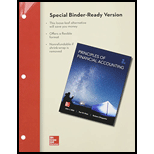
1.
Indicate the total amount of cash and cash equivalents of Incorporation A for the fiscal years ended September 28, 2013, and September 29, 2012, and compute the percentage of cash in current assets, total current liabilities, total shareholders’ equity, and total assets for the said dates, and interpret the trends.
1.
Explanation of Solution
Cash and cash equivalents: Cash is the money readily available in the form of currency. Cash equivalents are the near-cash items, which are readily convertible into cash. Cash equivalents have a maturity period of three months, or less than 3 months. Cash equivalents are reported along with cash in the assets section of the
Balance of cash and cash equivalents: Cash and cash equivalents of Incorporation A as on September 28, 2013 are $14,259,000,000 and on September 29, 2012 are $10,746,000,000.
Percentage of cash in current assets: In 2013, Incorporation A represents 19.5%
Percentage of cash in current liabilities: In 2013, Incorporation A represents 32.7%
Percentage of cash in shareholders’ equity: In 2013, Incorporation A represents 11.5%
Percentage of cash in total assets: In 2013, Incorporation A represents 6.9%
Interpretation of the trends: Since cash and cash equivalents increased much more than the respective bases, the percentage of cash increased. Hence, the liquidity position of Incorporation also increased.
Note: Refer to the Appendix A of the textbook, to find the referred values of Incorporation A, in the Consolidated Balance Sheets, as at September 28, 2013.
2.
Indicate the percentage change in beginning and ending cash and cash equivalents as per the statement of
2.
Explanation of Solution
Percentage change of cash and cash equivalents for the year ended September 28, 2013: In 2013, cash and cash equivalents changed from $10,746,000,000 in the beginning of the year to $14,259,000,000 in the ending of the year. The percentage increased by 32.7%
Percentage change of cash and cash equivalents for the year ended September 29, 2012: In 2012, cash and cash equivalents changed from $9,815,000,000 in the beginning of the year to $10,746,000,000 in the ending of the year. The percentage increased by 9.5%
Note: Refer to the Appendix A of the textbook, to find the referred values of Incorporation A, in the Consolidated Statement of Cash Flows for the years ended September 28, 2013 and September 29, 2012.
3.
Compute days’ sales uncollected of Incorporation A, for the years ended September 28, 2013 and September 29, 2012.
3.
Explanation of Solution
Days’ sales uncollected: This ratio measures the number of days a company takes to collect its accounts receivables. This ratio analyzes the period for which the receivables are outstanding. So, this ratio gauges the efficacy of collecting receivables. Lower the ratio, more efficient the collection of receivables.
Formula for days’ sales uncollected:
Compute days’ sales uncollected of Incorporation A for the year ended September 28, 2013.
Compute days’ sales uncollected of Incorporation A for the year ended September 29, 2012.
Analysis: The days’ sales uncollected has changed from 25.49 days in 2012 to 27.98 days in 2013. This denotes that the ratio increased from 2012 to 2013, hence, the efficiency of collection of receivables decreased.
Note: Refer to the Appendix A of the textbook, to find the referred values of Incorporation A, in the Consolidated Balance Sheets, as at September 26, 2015.
4.
Compute days’ sales uncollected of Incorporation A, for the year ended September 26, 2015 and September 27, 2014.
4.
Explanation of Solution
Compute days’ sales uncollected of Incorporation A for the year ended September 26, 2015.
Compute days’ sales uncollected of Incorporation A for the year ended September 27, 2014.
Analysis: The days’ sales uncollected has changed from 34.86 days in 2014 to 26.31 days in 2015. This denotes that the ratio decreased from 2014 to 2015, hence, the efficiency of collection of receivables increased.
Note: Refer to the website given in the question for the values of Incorporation A, in the Consolidated Balance Sheets, as at September 26, 2015.
Want to see more full solutions like this?
Chapter 8 Solutions
Principles of Financial Accounting, Chapters 1-17 - With Access (Looseleaf)
- Accounting problem with correctarrow_forwardMila Services collected $278,000 from customers in 2022. Of the amount collected, $134,000 was from services performed in 2021. In addition, Mila performed services worth $189,000 in 2022, which will not be collected until 2023. Mila Services also paid $217,000 for expenses in 2022. Of the amount paid, $156,000 was for expenses incurred on account in 2021. In addition, Mila incurred $172,000 of expenses in 2022, which will not be paid until 2023. Compute 2022 cash-basis net income.arrow_forwardRamos Corporation deposits all cash receipts on the day they are received and makes all cash payment by check.arrow_forward

 AccountingAccountingISBN:9781337272094Author:WARREN, Carl S., Reeve, James M., Duchac, Jonathan E.Publisher:Cengage Learning,
AccountingAccountingISBN:9781337272094Author:WARREN, Carl S., Reeve, James M., Duchac, Jonathan E.Publisher:Cengage Learning, Accounting Information SystemsAccountingISBN:9781337619202Author:Hall, James A.Publisher:Cengage Learning,
Accounting Information SystemsAccountingISBN:9781337619202Author:Hall, James A.Publisher:Cengage Learning, Horngren's Cost Accounting: A Managerial Emphasis...AccountingISBN:9780134475585Author:Srikant M. Datar, Madhav V. RajanPublisher:PEARSON
Horngren's Cost Accounting: A Managerial Emphasis...AccountingISBN:9780134475585Author:Srikant M. Datar, Madhav V. RajanPublisher:PEARSON Intermediate AccountingAccountingISBN:9781259722660Author:J. David Spiceland, Mark W. Nelson, Wayne M ThomasPublisher:McGraw-Hill Education
Intermediate AccountingAccountingISBN:9781259722660Author:J. David Spiceland, Mark W. Nelson, Wayne M ThomasPublisher:McGraw-Hill Education Financial and Managerial AccountingAccountingISBN:9781259726705Author:John J Wild, Ken W. Shaw, Barbara Chiappetta Fundamental Accounting PrinciplesPublisher:McGraw-Hill Education
Financial and Managerial AccountingAccountingISBN:9781259726705Author:John J Wild, Ken W. Shaw, Barbara Chiappetta Fundamental Accounting PrinciplesPublisher:McGraw-Hill Education





